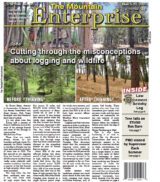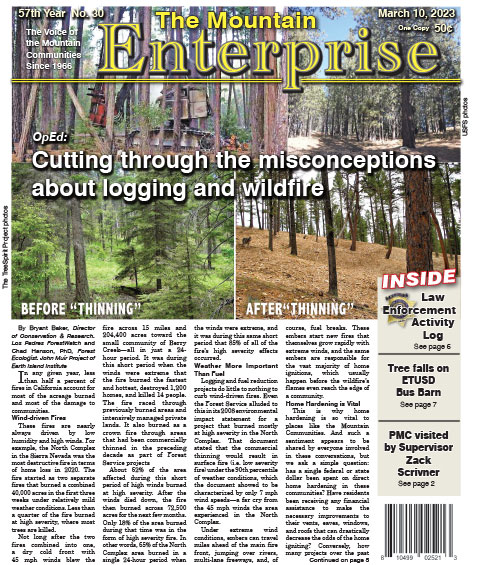By Bryant Baker, Director of Conservation & Research, Los Padres ForestWatch and Chad Hanson, PhD, Forest Ecologist, John Muir Project of Earth Island Institute
In any given year, less than half a percent of fires in California account for most of the acreage burned and most of the damage to communities.
Wind-driven Fires
These fires are nearly always driven by low humidity and high winds. For example, the North Complex in the Sierra Nevada was the most destructive fire in terms of home loss in 2020. The fire started as two separate fires that burned a combined 40,000 acres in the first three weeks under relatively mild weather conditions. Less than a quarter of the fire burned at high severity, where most trees are killed.
Not long after the two fires combined into one, a dry cold front with 45 mph winds blew the fire across 15 miles and 204,400 acres toward the small community of Berry Creek—all in just a 24-hour period. It was during this short period when the winds were extreme that the fire burned the fastest and hottest, destroyed 1,200 homes, and killed 14 people. The fire raced through previously burned areas and intensively managed private lands. It also burned as a crown fire through areas that had been commercially thinned in the preceding decade as part of Forest Service projects
About 62% of the area affected during this short period of high winds burned at high severity. After the winds died down, the fire then burned across 72,500 acres for the next few months. Only 18% of the area burned during that time was in the form of high severity fire. In other words, 65% of the North Complex area burned in a single 24-hour period when the winds were extreme, and it was during this same short period that 85% of all of the fire’s high severity effects occurred.
Weather More Important Than Fuel
Logging and fuel reduction projects do little to…(please see below to view full stories and photographs)
Photo captions:
Before “Thinning” and After “Thinning”
Stand Type: Pine Before Treatment and Stand Type: Pine After Treatment
To see full stories with photos, please purchase a copy of the newspaper at many locations (click this link for a list) throughout the Mountain Communities.
Or, have your newspaper delivered via mail and include internet access. Just call 661-245-3794. Classified ads are FREE to paid subscribers! See front page at www.mountainenterprise.com for details.
The e-Edition is available now with full photos and stories at The Mountain Enterprise e-Edition. Select the 2023-0310 edition.
(subscriber login required)
This is part of the March 10, 2023 online edition of The Mountain Enterprise.
Have an opinion on this matter? We'd like to hear from you.

![[USFS photo]](https://mountainenterprise.com/wp-content/uploads/Mechanical-thinning_USFS-pic-324x243.jpg)

